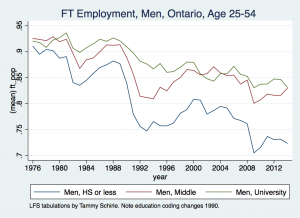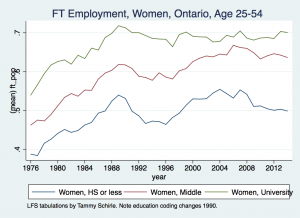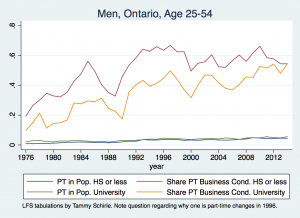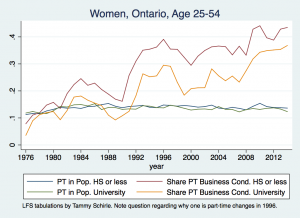
When faced with an interesting puzzle, I tend to start plotting statistics. (Warning: This post is about me thinking out loud about the statistics I’ve looked at this morning. You may or may not find that interesting)
Recently I’ve been staring at the changes in full-time employment rates among men in Canada, particularly Ontario. This has been pointed out several times by Mike Moffatt (Western) and is certainly concerning – in every recession there has been a loss in employment that persists, and that employment was full-time. What makes it puzzling and interesting to me is that we don’t necessarily see the same trends for women. So in looking for an explanation for what is happening in our labour markets, I think we need to take a gendered approach and seek explanations that can account for such gender differences.
A gendered approach is not obvious – long-run secular trends complicate everything (all these women just keep working more), so many prefer to just focus on men given their seemingly stable role as ”œtraditional” breadwinners. I am not so inclined.
In Figure 1 I’ve plotted full-time employment rates for men in Ontario, by education level (broadly grouped as high school or less, university, and everyone in between). We can see full-time employment rates take a hit in every major recession.
For this reason, it seems promising to look at recent literature on job polarization to make sense of men’s full time employment. Jaimovich and Siu’s recent NBER paper ( ”œThe trend is the cycle: job polarization and jobless recoveries”) found that during recessions many routine, middle skill jobs simply disappear.
I am not quick to dismiss Henry Siu’s work (really nice and smart guy at UBC, and my former prof), but the problem I have with this explanation for understanding the Canadian data is two-fold. First, if this were just a job polarization story, shouldn’t we see clearer differences across education groups in figure 1? Instead, we actually see the most ”˜permanent’ damage to full time jobs in post-recession periods among those men with university degrees. The most severe persistent damage is for those with less than high school. It’s just not primarily about those guys in the middle. My caveat: I’d need to look at occupations more directly to really rule this one out, but that requires something more than public use data.
The second reason I question the job polarization story is that we don’t see the same type of trends for women (figure 2). It is difficult to separate the secular trends from cyclical, and one must note that aggregate trends in women’s employment in part capture increases in women’s education over time. However, within each education group, we don’t see the same type of loss in full-time employment as we see for men.
So I start looking at part-time work.
The shift away from full-time work was not entirely a direct shift into part time work. Rather, for men the increase in part time work has been fairly gradual and increases across all education groups. Moreover, and perhaps surprising, the portion of men working part time in each education group is roughly the same. However, the portion of part-timers that report business conditions as the reason for working part time does appear to have some cyclical component that we would expect. For those with education less than university, we see jumps in involuntary part-time in the early 80s and 90s that persisted, but not in the most recent recession. The most recent recession only resulted in an increase in university-educated men reporting they worked part time for reasons related to business conditions.
Women are quite different, especially in the most recent recession. The likelihood of working part time (represented as a portion of the female population here) has remained remarkably stable since 1976. However, among part-timers (in all education groups) there were huge jumps in the portion working part time due to business conditions (involuntary) and this is also true in the most recent recession.
And that is where I have run out of time to play with statistics today. I remain puzzled. It’s not obvious what mechanisms are at work here. However, I am inclined to think more about families. In many ways, women’s experiences in the labour market are looking more and more like men’s, and men’s experiences are looking more and more like women’s.
In other words, I suspect the labour markets for men and women are finally converging, however slowly. Perhaps recessions are nudging us, however reluctantly, toward such convergence. If that’s what we’re seeing, we should see a great deal of renegotiation within families alongside that – Dad takes on more part time work and more of the household responsibilities while Mom takes on more work in the paid labour market. Beyond the usual anecdotes, we’re seeing some statistical evidence of those trends. Now I just need to find time to see how well we can line that all up in a meaningful way.













